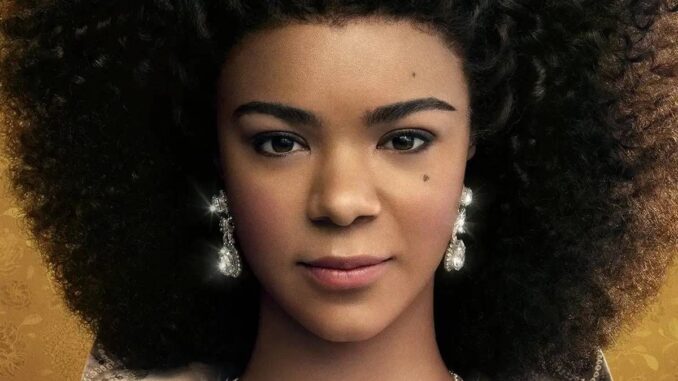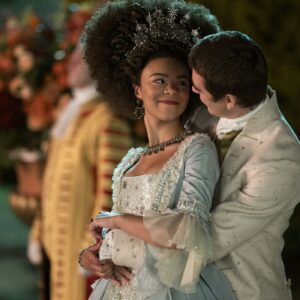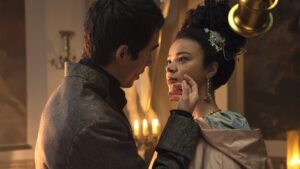
After two relatively successful previous seasons, Netflix and Shondaland recently released a new season of the Bridgerton TV Series called Queen Charlotte. It was thought that the third season of the series would continue the story of Colin and Penelope, but surprisingly, this is a spin-off, following the life of Queen Charlotte.
Following the life of the above character, the film is a journey from when she was a princess in faraway Germany, to when she married King George III and then became Queen, taking responsibility for finding the next successor when the whole court fell into chaos.
While seasons 3 and 4 are still filming, focusing on a supporting character compared to the plot of the previous 2 Bridgerton seasons could be a completely smart calculation, when Shondaland needs to consider more in the new seasons, when the previous season received quite a few negative reviews.

The “great experiment” between two skin colors, two races?
Consisting of 6 episodes, Queen Charlotte has two parallel storylines, not following a linear pattern but interwoven to create a polysemous and quite complex structure. Just a few days after its release, it climbed to the Top 1 Netflix globally with about 150 million hours of viewing upon its release. What makes this work successful?
First of all, it tells a very different story from other works of the same genre. The fact that Queen Charlotte has dark skin is a recent controversy, but more importantly, the meaning and content are cleverly included by the film crew.
In this work, Queen Augusta (mother of King George III) and the court called the combination of two skin colors and two races the “Great Experiment”. They followed each step of the marriage, to evaluate whether a seemingly crazy idea would come true?
Not only in the two main characters, but the experiment also helped to give the nobility more diversity. During the ball, we can see an acknowledgement of both Asian and African descent. This is almost unimaginable, and it can be seen that Queen Charlotte is aiming for a greater meaning of unity, even though this is just a fictional work.
Therefore, although it is not yet consistent with historical events, the film has still created quite a few positive impressions, attracting a large number of viewers. From skin color, ethnicity, gender… the film also evokes other more current issues, which are still alive today. One of them is the role of women. Besides depicting many shackles that have oppressed them, such as giant dresses, arranged marriages… the film also shows relatively secret desires, like when D.H. Lawrence first wrote Lady Chatterley’s Lover.
Representing this perspective are the two ladies Danbury and Violet. Despite the “high fences” of that era, both of them always wanted their “garden” to truly bloom. Danbury, a black woman from the wealthy kingdom of Sierra Leone, is also a symbol of the struggle to rise to the aristocracy, as well as to protect her family fortune when her husband died.
In addition, the role of motherhood is also exploited in a touching way. Although not expressed through dialogue, Princess Augusta and even Charlotte after their old age show us the instinct of a mother to always protect her children. Even though they are misunderstood or underestimated, they still shine with that duty.
Deep romance or love that surpasses everything?

In addition to the above mentioned issues of struggle, love is also another factor that makes the work different. Although this spin-off is not based on the original works of novelist Julia Quinn, the romantic and sweet nature is still preserved.
Here we still see the love at first sight, noble feelings, “love at first sight”… told between the princess and the prince who seemed like a dream. The story has the same motif of a stubborn beginning and then gradually changing, which is classic in romantic works.
The biggest highlight of this film is the relationship between Charlotte and King George III, and the complexities in the relationship between the two of them. Viewers go from doubt, confusion… and then finally realize that sacrifice is the most important, and it helps love have a truly different position.
However, the film also explores other lines. These are characters that seem to be secondary, such as the two assistants, Charlotte’s personal friend – the Princess of Danbury as well as Violet. The relationships that overcome the walls of gender, skin color, age, limits… in the secrecy of a somewhat harsh institution, bring many emotions to the audience.
Still a royal court with luxury and intrigue, but Queen Charlotte has a somewhat new experiment, showing that the power of great love can overcome many other prejudices. But is she a person of color, or is this work just “pink-izing”?
Trying to find a solution to the film’s controversies
Although successful, Queen Charlotte also encountered some mixed reactions as mentioned above. Although it is known that this is a work of fiction, the issue of skin color and the power of people of color in a real-life context can cause many viewers to misunderstand.
Regarding history books, there is an anecdote that Queen Charlotte was born into the German nobility, in the Mecklenburg-Strelitz region, and was described as “broad-nosed, thick-lipped, with a Mulatto face”. Charles Dickens in the novel The Two Cities also said that she was only of average beauty.
Many portraits painted during that period that are still preserved to this day have also confirmed the above. However, in this film, the Queen Mother often wanted the painter to put a highlight on Charlotte’s face, while she wanted to reflect her true skin color. Therefore, the portraits are not good evidence for us to believe.
In addition, historians have also discovered that her family also has a branch of the Moorish family tree (a term used to describe black Africans or Arabs of North African origin). This is because in 1997, historian Mario de Valdes y Cocom claimed in his research that Queen Charlotte was a descendant of “the illegitimate child of King Alfonso I of Portugal and his Moorish mistress [Madragana].”
However, even if she had a grandmother who was Moorish, it is still not enough to confirm that she was black. Because from its inception until now, the word Moor used to refer to ethnicity has had many meanings, sometimes used to refer to Muslims, and sometimes to refer to light-skinned North Africans. Recently, viewing it as a “static concept” has been opposed by many anthropologists.
Another addition is that the genealogical branch from Cocom’s research, as mentioned above, is nearly 600 years after Charlotte was born (King Alphonso I was born in 1109 or 1111, and Queen Charlotte was born in 1744), so that any mixing in the bloodline (if any) has more or less faded after nearly 6 centuries.
From the above, it can be seen that there is not much possibility that Queen Charlotte was of color. However, because of its deeper vision of current and progressive issues, the film has been viewed differently, more broadly, and has not been entangled in controversy.
